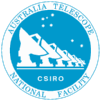Explanation of Development Stages
Schedule groups the development work into distinct stages. This page gives more background on each of those.
- We plan to start with simulated CABB output files, which should be available by 2007 Oct. Many of the CABB output formats have been written already, by various observatory systems (MOPS, Parkes DFBs) using the ATNF's standard RPFITS library; the changes to Miriad mainly relate to handling the larger number of IFs and spectral channels within the data files. Shortly after the first test data starts appearing (Nov 2007) it will be possible to read it into Miriad and do basic processing of the full bandwidth, under the same assumptions as at present about which calibration parameters have negligible variation with frequency across the bandpass. At this stage interactive review and flagging of the UV data will be necessary. Some changes to the data selection subroutines and the INVERT task may be needed before images can be formed.
- The next phase is to create scripts that will process the entire bandwidth in sections, relieving users of a lot of book-keeping. This will be ready when CABB stage 1 is complete (Apr 2008). These scripts could trivially be made to process the data for the separate frequency bands in parallel and thus make good use of multi-processor machines or clusters. Forming continuum images by summing deconvolved images of the subsections will somewhat limit the quality that can be achieved.
- The zoom bands are subsections of wide bands, and thus can make use of the calibration derived for their "parent" wide band. Cross-calibration procedures for the zoom bands will be developed and tested towards the end of the commissioning period. This work should be relatively straightforward but provides a distinct chunk of functionality, so we have shown as a distinct stage.
- The large number of channels in CABB data and the large data volume will make automated flagging highly desirable, possibly essential. The next stage of work focuses on this area. New heuristics will be needed to remove RFI sources similar to the 128MHz "birdie" that affects current data, and make use of new "bad data" indicator flags in the CABB data files. This work will start shortly after our Stage 1 code is released (Mar 2008) and continue through the early part of the commissioning period (Apr-Jul 2008). Work on new flagging methods employing the auto-correlation data will be pursued in this period as well. Some further work in this area (using data from dedicated RFI monitoring antennae) may be required when the new 1-3GHz receivers are installed (Mar 2009).
Because the autocorrelation data will be routinely available from the CABB correlator, this opens the possibility of using the array as a group of single dishes and doing rapid single-dish mapping of the sky. This is probably best addressed by having the online system write a different format data file from the correlator, since it requires observing methods (on-off scans) quite different to those used in interferometry. As such this would be out of scope for this project. However it is clearly desirable to be able to extract the autocorrelations from an interferometer observation and feed them into some single dish package such as ASAP. Such extraction is in-scope for this project.
- The existing miriad code is adequate for handling data with up to 30% fractional bandwidth. The CurrentBandwidths table shows that there will be no requirement to handle larger fractional bandwidths until well into 2009. Accordingly we have scheduled the work on handling large fractional bandwidths in the later stages; Stage 5 and 6 will start in the second half of 2008 and continue until the last quarter of 2009. Some of the work in stage 6 should continue after the project close and then form part of regular Miriad maintenance and improvement.
- The final stage will require input from the user community; until we have some experience with the instrument it will not be clear which parts of Miriad should be updated in order to get the maximum science from CABB. At present we can see three somewhat intertwined changes that could be made, all in the area of improving image quality. The first is a fairly distinct set that centres on improving the polarization tasks in miriad (Changes/polarization); some of the implementation details impact other changes. The other two are more interconnected - improving the Multi Frequency Synthesis code to cope with large fractional bandwidths and implementing new algorithms to improve dynamic range (for example streamlining the "peeling" method described by Oosterloo, or handling the frequency-dependence of the primary beam shape). The interconnection comes because MFS can significantly reduce artifacts in the finished image, thus producing higher dynamic range.
